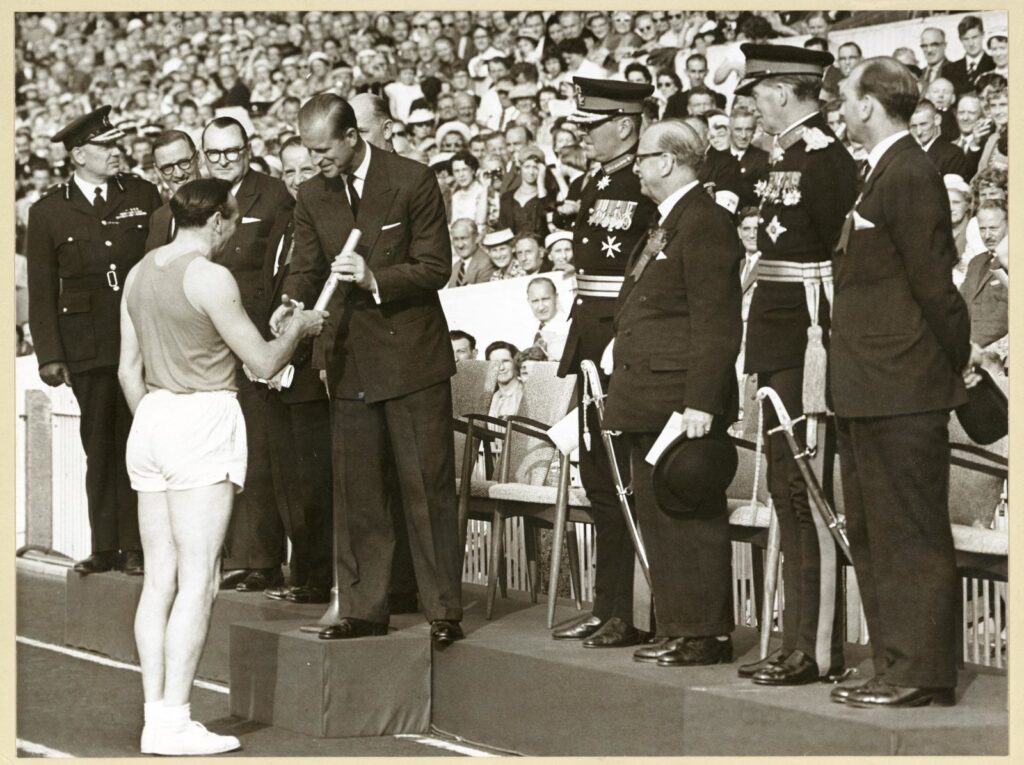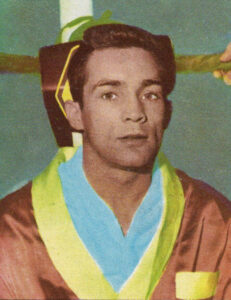1958 British Empire and Commonwealth Games
ATHLETES and sporting officials from 35 nations descended upon Wales’s capital city, Cardiff, for the staging of the 1958 British Empire and Commonwealth Games.
A total of 1,122 competitors took part in the sports of athletics, boxing, cycling, fencing, bowls, rowing, swimming and diving, weightlifting and wrestling between July 18-26.
In addition to the use of Cardiff Arms Park for the opening and closing ceremonies and the athletics events, other venues included Cardiff’s Wales Empire Pool, built especially to host the swimming and diving, Sophia Gardens for the boxing bouts, Maindy Stadium for the cycling and Llyn Padarn, Llanberis, for the rowing.
The Games were officially opened by Prince Philip, the Duke of Edinburgh.
The 1958 Games introduced the Queen’s Baton Relay – intended to symbolise peace and harmony through sports participation – which has been conducted as a prelude to every British Empire and Commonwealth Games ever since.
The Queen’s message, signed Elizabeth R, and dated July 14, 1958, was sent from Buckingham Palace to Cardiff via the baton relay. The silver-gilt and enamel baton was designed by Cardiff jeweller and former soldier, Colonel Roy Crouch, Chairman of the Games’ Medals Committee. Measuring 40cm in length and 4cm in diameter, it was decorated with Welsh national symbols, namely a red dragon, daffodils and leeks, along with crowns representing the royal connection.

The baton set off from the forecourt of London’s Buckingham Palace, the residence of Queen Elizabeth, Head of the Commonwealth, carried by Dr Roger Bannister, the first sub-four-minute miler, escorted by fellow 1954 Games champions Chris Chataway and Peter Driver. The relay took it through several English counties and all 13 Welsh counties on its four-day journey to Cardiff.
A total of 664 athletes, including 32 schoolboys, were involved in the relay, which covered more than 600 miles. The message passed through Llangollen, Wrexham, Flint, Llandudno and Caernarfon before heading south down the west coast through Dolgellau, Aberystwyth, Cardigan and Haverfordwest. The relay wound around the coast from Carmarthen, Llanelli, Swansea and Bridgend before it covered the valleys of the south through Aberdare, Brynmawr, Abergavenny and Newport, then on to Cardiff.
Following a trumpet fanfare and six-gun salute, on Friday, July 18, at 6.33pm, the final-leg runner entered the Arms Park stadium to complete the relay. This athlete’s identity had been kept a closely guarded secret and rapturous applause rang out from the 40,000 spectators when he was revealed as former Wales rugby player and Olympic silver sprint relay medallist, 36-year-old Ken Jones of Newport.
Donning a red vest complete with Welsh badge and white shorts, Jones appeared in the competitors’ entrance before running once around the cinder track, holding the baton aloft. He then stopped in front of the Duke of Edinburgh, the President of the Commonwealth Games Federation, and handed him the baton.
Before officially opening the Games, the Duke proceeded to read the Queen’s message to the crowd:
‘To all athletes assembled at Cardiff for the 6th British Empire and Commonwealth Games I send a warm welcome and my very best wishes. I am delighted that so many Commonwealth countries have sent teams to Wales for these Games. The number is larger than ever and more than three times as great as for the first meeting at Hamilton in 1930. This is welcome proof of the increasing value which is being placed today on physical strength and skill as an essential factor in the development of the whole man, healthy in mind and body. It also gives the greatest personal pleasure to know that so many members of the Commonwealth family are meeting in friendly rivalry and competition. I hope that many lasting friendships will grow from this great meeting of athletes and spectators, and that you will all go home with a better understanding of the value of our Commonwealth of nations. I am greatly looking forward to being with you at the end of next week.‘
In the event, illness prevented the Queen from attending the closing ceremony in person, but it proved to be an historic occasion nevertheless. A recorded message was played to the crowd in which Her Majesty announced: “I intend to create my son Charles, Prince of Wales today. When he is grown up, I will present him to you at Caernarfon.”

Howard Winstone
The 1958 Games themselves proved to be a success. Despite being the smallest ever host nation, Wales’s superbly organised sporting spectacle did the country proud and was recognised at the time as a magnificent occasion which celebrated the cream of athletic strength and stamina on a global stage.
Cardiff did witness anti-apartheid protests against the all-white South African team, although games organisers responded that non-white South Africans were ineligible as their associations were not affiliated to the international federations. South Africa left the Commonwealth three years later and next appeared at the Games in 1994.
Participating Commonwealth countries and territories were:
Australia, The Bahamas, Barbados, British Guiana, Canada, Ceylon, Dominica, England, Fiji, Ghana, Gibraltar, Hong Kong, India, Isle of Man, Jamaica, Jersey, Kenya, Federation of Malaya, Malta, Mauritius, New Zealand, Nigeria, North Borneo, Northern Ireland, Northern Rhodesia, Pakistan, Saint Vincent and the Grenadines, Sarawak, Scotland, Singapore, Sierra Leone, South Africa, Southern Rhodesia, Trinidad and Tobago, Uganda and hosts Wales.
England topped the medal table with 80 medals in total, including 29 gold. Wales finished 11th with their sole gold medal being won by the Merthyr-born bantamweight boxer Howard Winstone. The home nation also collected three silvers and seven bronze.